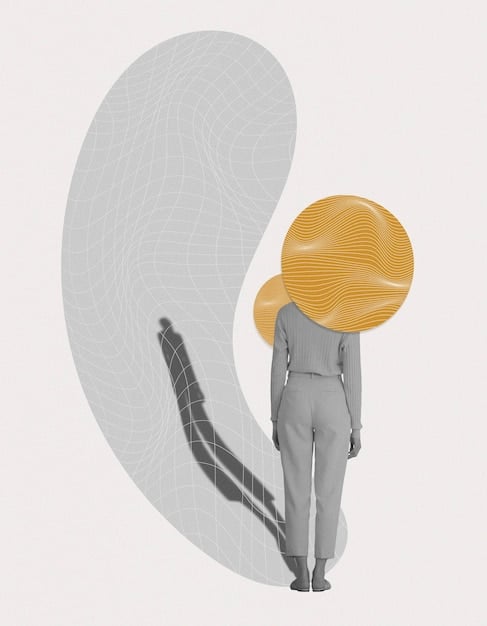Cognitive Dissonance in the US: Resolve Conflicting Beliefs

Cognitive dissonance describes the mental discomfort experienced when an individual holds conflicting beliefs, values, or attitudes, or when their actions contradict their beliefs, leading to psychological stress often resolved through belief adjustment or behavioral change within the United States context.
Have you ever felt that unsettling tension when your actions just don’t align with what you truly believe? That internal friction, often subtle yet persistent, points to a fundamental human psychological phenomenon: understanding cognitive dissonance: how to resolve conflicting beliefs and behaviors in the US. This mental discomfort arises when one holds two or more conflicting beliefs, attitudes, or values, or when one’s actions contradict those internal tenets.
What is cognitive dissonance?
At its core, cognitive dissonance is a theory in social psychology first proposed by Leon Festinger in 1957. It describes the mental stress or discomfort experienced by an individual who holds contradictory beliefs, ideas, or values, or is confronted by new information that conflicts with existing beliefs, ideas, or values. This discomfort motivates individuals to reduce the dissonance, often by changing one’s beliefs, attitudes, or behaviors, or by rationalizing the contradiction.
The concept is foundational to understanding both individual psychology and broader societal dynamics. For residents in the US, navigating a diverse landscape of political, social, and cultural ideologies often brings individuals face-to-face with dissonant cognitions. Whether it’s supporting a political candidate whose policies diverge from personal values or engaging in behaviors that contradict one’s stated principles, dissonance is a common, though often unrecognized, part of daily life.
The origin and theory of cognitive dissonance
Leon Festinger developed the theory after observing how people reacted to disconfirming evidence in a doomsday cult. His insights revealed that rather than abandoning their beliefs when a prophecy failed, followers often strengthened their conviction, rationalizing the outcome to reduce the psychological discomfort. This initial observation laid the groundwork for a robust theory that explains a wide range of human behaviors, from consumer choices to political affiliations.
- Cognition: Refers to any piece of knowledge, opinion, or belief about the world, oneself, or one’s behavior.
- Dissonance: Occurs when two or more cognitions are inconsistent with each other.
- Magnitude of Dissonance: The intensity of discomfort depends on the importance of the cognitions involved and the number of dissonant cognitions.
- Motivation to Reduce: Individuals are motivated to reduce dissonance, much like hunger or thirst, due to the uncomfortable psychological state it creates.
Understanding these basic tenets is crucial for anyone studying human behavior or seeking to comprehend why people sometimes act in seemingly irrational ways. The theory posits that the greater the dissonance, the stronger the drive to reduce it. This drive can manifest in various ways, from altering beliefs to seeking out information that supports existing views, thereby minimizing the perceived conflict.
In essence, cognitive dissonance illuminates the human desire for internal consistency. We strive for a psychological balance, and when that balance is disturbed by conflicting thoughts or actions, we are compelled to restore equilibrium. This makes the theory incredibly powerful in explaining why individuals might change their minds, rationalize bad decisions, or even resist undeniable evidence that challenges their core beliefs.
Common manifestations in US society
Cognitive dissonance isn’t just an abstract psychological concept; it’s a pervasive force shaping individual and collective behaviors across the United States. Its manifestations are diverse, appearing in areas from political polarization to consumer habits and even personal health choices. Recognizing these patterns can offer profound insights into the nuances of American social psychology.
Political and ideological dissonance
Perhaps one of the most prominent arenas for cognitive dissonance in the US is the political landscape. The deep partisan divide often forces individuals to reconcile conflicting ideas or support political stances that may not fully align with all their personal values. For instance, a voter might prioritize economic stability yet support a party whose social policies contradict their personal ethical framework. This creates an internal struggle that requires resolution.
- Party Loyalty vs. Personal Values: Voters often rationalize supporting an entire party platform, even if specific planks conflict with their individual beliefs, to maintain a consistent political identity.
- Information Overload and Confirmation Bias: In an era of abundant information, individuals frequently selective exposure themselves to news sources that confirm their existing beliefs, avoiding data that might induce dissonance.
- Moral Dilemmas in Policy: Debates surrounding issues like healthcare, climate change, or social justice often present profound moral conflicts, where an individual’s stance might create dissonance with deeply held humanitarian or economic principles.
This dynamic is fueled by a strong desire to belong and identify with a group, whether a political party, a social movement, or an ideological faction. Conforming to group norms, even if it means some internal inconsistency, can be a powerful way to reduce the discomfort of standing alone or holding an unpopular view. The American political system, with its two dominant parties, often exacerbates this by presenting stark, binary choices that amplify potential dissonant experiences.

Consumer behavior and ethical considerations
Beyond politics, cognitive dissonance significantly influences consumer behavior. Many Americans face a disconnect between their stated ethical concerns (e.g., environmental protection, fair labor practices) and their purchasing habits. The desire for convenience, affordability, or status often clashes with broader societal or personal values, leading to dissonance.
- “Fast Fashion” vs. Sustainability: Consumers might express concerns about textile waste or unethical labor but continue to purchase inexpensive, trend-driven clothing.
- Ethical Sourcing vs. Price: A desire to support ethically sourced or organic products often conflicts with budget constraints, leading to rationalizations about value or necessity.
- Health Choices vs. Instant Gratification: Individuals who value health and wellness may still consume unhealthy foods or engage in sedentary behaviors, creating internal conflict that requires justification.
The marketplace is rife with opportunities for dissonance, as marketing often appeals to aspirational values while product realities may fall short. Consumers might minimize the negative impact of their choices or exaggerate the benefits of a purchase to alleviate the discomfort. This constant interplay between ideals and reality is a powerful driver of consumer psychological processes in the US.
Furthermore, the abundance of choice in American consumer culture can amplify dissonance. With so many options available, each potentially offering different trade-offs, the decision-making process itself can become a source of internal conflict, leading to post-purchase rationalization—convincing oneself that the chosen item was indeed the best option, despite any lingering doubts. This mechanism ensures that people maintain a positive self-image regarding their decisions, even when faced with alternatives.
Mechanisms for resolving dissonance
When confronted with cognitive dissonance, individuals are not passive recipients of discomfort. Instead, they actively employ various strategies to reduce the unsettling tension. These resolution mechanisms are fundamental to maintaining psychological equilibrium and can manifest in conscious choices or subconscious processes. Understanding them is key to comprehending human resilience and sometimes, self-deception.
Changing beliefs or attitudes
One of the most direct ways to resolve cognitive dissonance is by altering an existing belief, attitude, or value. This often happens when the conflicting evidence is too strong to ignore, or when the behavior is already entrenched. For instance, a person who smokes (behavior) but knows it’s harmful (belief) might change their belief about smoking’s severity (“it’s not that bad,” “I’ll quit later”) to reduce the dissonance. Alternatively, they might finally quit smoking, thus aligning their behavior with their belief about health.
- Minimizing Importance: Downplaying the significance of one of the conflicting cognitions. “My vote won’t really change anything in the grand scheme.”
- Adding Consonant Cognitions: Introducing new beliefs that support the behavior or attitude, thereby outweighing the dissonant ones. “I buy fast fashion, but at least I donate my old clothes.”
- Changing One of the Cognitions: Directly altering a belief to align with a behavior or another belief. “Maybe this diet isn’t actually that effective, so my cheating doesn’t matter.”
This mechanism highlights the remarkable adaptability of the human mind. Rather than dwelling in uncomfortable contradiction, people will re-evaluate their internal frameworks to achieve a sense of consistency. This can be empowering when it leads to positive change, but it can also be a form of self-deception when it involves rationalizing harmful behaviors or unfounded beliefs.
Changing behavior
While altering internal cognitions is a common strategy, sometimes the most effective way to reduce dissonance is by directly changing one’s behavior. This means aligning actions with existing beliefs. For example, if someone believes in environmental stewardship but drives a gas-guzzling car, they might resolve this by purchasing a more fuel-efficient vehicle or actively advocating for public transportation.
Behavioral change is generally a more effortful and often a more visible form of dissonance reduction. It requires overcoming inertia and sometimes making significant lifestyle adjustments. However, it can also lead to genuine personal growth and greater integrity, as one’s actions become a more accurate reflection of their values.
- Adopting New Habits: Beginning a new activity that aligns with desired beliefs, such as volunteering for a cause one believes in deeply.
- Cessation of Conflicting Actions: Stopping behaviors that directly contradict important values or goals, like quitting a job that goes against one’s ethics.
- Incremental Adjustments: Making small, manageable changes over time that gradually bring behavior into alignment with beliefs, making the transition less overwhelming.
The decision to change behavior often stems from a high magnitude of dissonance, where the psychological discomfort becomes unbearable, or from external pressures and opportunities that make behavioral change more feasible. This form of resolution is often seen as the most authentic, as it demonstrates a commitment to one’s principles through tangible actions.
Impact of information and social influence
The resolution of cognitive dissonance doesn’t occur in a vacuum. It is heavily influenced by the availability of information and the pervasive power of social influence. In the interconnected society of the US, these factors play a critical role in how individuals perceive, experience, and ultimately address their internal conflicts.
Selective exposure and information processing
One common way individuals manage dissonance is through selective exposure to information. People tend to seek out information that supports their existing beliefs and avoid information that might challenge them, thereby preventing or reducing dissonance. This is particularly evident in the digital age, where algorithms often curate content that reinforces existing viewpoints, creating echo chambers.
- Confirmation Bias: Actively seeking out or interpreting information in a way that confirms one’s preconceptions.
- Selective Attention: Paying attention only to information that is consistent with one’s views, filtering out contradictory data.
- Source Credibility: Attributing higher credibility to sources that support one’s existing beliefs, and dismissing those that don’t.
This phenomenon can lead to strong polarization, as individuals become less exposed to diverse perspectives, making it harder to reconcile conflicting ideas. In the US, this is observable across political, social, and even cultural divides, where media consumption often reflects and reinforces existing biases rather than challenging them. The result is often a deepening of pre-existing beliefs, even in the face of counter-evidence, simply to avoid the discomfort of dissonance.

Social influence and group norms
Social influence exerts a powerful effect on how individuals experience and resolve cognitive dissonance. The desire for social acceptance and belonging often motivates people to conform to group norms, even if those norms contradict personal beliefs. This can lead to public compliance without private acceptance, or it can lead to genuine internalization of group beliefs to reduce the dissonance between private thoughts and public actions.
When an individual’s beliefs or behaviors deviate from their social group, they experience pressure to conform. If they resist, the dissonance from failing to conform to group expectations can be substantial. Conversely, if they conform, they might experience dissonance between their true beliefs and their enacted behavior.
- Peer Pressure: Adopting behaviors or attitudes to fit in with a particular social group, even if it feels inauthentic.
- Groupthink: Suppressing dissenting opinions within a group to maintain harmony, leading to unanimous decisions that might not be optimal.
- Public Commitment: Once an individual publicly commits to a belief or action, the pressure to maintain consistency is immense, creating dissonance if they consider diverging.
This dynamic is especially prominent in US culture, which often values individualism but also places a strong emphasis on community and belonging. Navigating these conflicting pressures can lead to subtle yet significant shifts in personal beliefs and behaviors, all aimed at reducing the pervasive discomfort of cognitive dissonance. The need to maintain a positive self-image within one’s social circles is a powerful underlying motivator.
Strategies for constructive resolution
Instead of passively succumbing to dissonance or resorting to self-deception, individuals can adopt proactive strategies to address these internal conflicts constructively. Moving beyond mere discomfort to genuine growth involves introspection, critical thinking, and a willingness to embrace complexity. This can lead to more coherent self-identities and more informed decision-making.
Embrace critical thinking and self-reflection
Consciously addressing cognitive dissonance begins with cultivating critical thinking skills and engaging in honest self-reflection. This involves examining one’s beliefs, attitudes, and behaviors objectively, identifying inconsistencies, and understanding their origins. Rather than immediately seeking to reduce discomfort through rationalization, the goal is to acknowledge the dissonance as a signpost for deeper understanding.
- Identify Core Values: Clearly define what truly matters to you to better identify where conflicts arise.
- Question Assumptions: Challenge long-held beliefs, especially those inherited from family or social groups, to see if they still align with your current understanding.
- Seek Diverse Perspectives: Actively consume information from a variety of sources, including those that challenge your worldview, to broaden your understanding and test your cognitions.
This introspective process can be challenging, as it often requires confronting uncomfortable truths about oneself or one’s group. However, by doing so, individuals can move beyond superficial resolutions and work towards genuine coherence between their internal landscape and external actions. It is a critical step towards authentic personal development.
Promoting open dialogue and empathy
Resolving cognitive dissonance, especially when it involves social or political issues, often benefits from open and empathetic dialogue. Engaging with others who hold conflicting views, not with the aim to persuade, but to understand, can reduce the perceived threat of disconfirming information. This fosters an environment where diverse cognitions can coexist, and individuals can explore compromises or new perspectives without feeling attacked.
In a polarized society like the US, fostering such dialogue is paramount. It involves active listening, suspending judgment, and finding common ground where possible. This approach can help individuals appreciate the complexity of issues, thereby potentially reducing the sharp edges of their own dissonant cognitions by realizing that multiple valid viewpoints can exist.
- Active Listening: Fully hearing and understanding another person’s perspective before formulating your response.
- Finding Common Ground: Identifying shared values or goals that can bridge differences, even amidst disagreement on specific issues.
- Practicing Empathy: Attempting to understand the emotional and psychological context from which another person’s beliefs arise.
By engaging in empathetic dialogue, the process of resolving dissonance becomes less about “winning” an argument and more about expanding one’s own understanding. This can lead to more nuanced beliefs and more flexible behavioral responses, paving the way for constructive change at both individual and societal levels.
Real-world case studies in the US
Examining specific instances of cognitive dissonance in the US provides tangible examples of how this psychological phenomenon plays out in everyday life and significant societal shifts. From personal health to national issues, these cases illustrate the power of the theory and its broad applicability.
Public health initiatives and individual choices
The domain of public health frequently highlights instances of cognitive dissonance, particularly in the US. Consider the widespread acceptance of scientific consensus on climate change and the individual behaviors that contribute to it. Many Americans acknowledge the reality of climate change and express concern about its impact, yet continue practices that have high carbon footprints, such as frequent air travel or reliance on single-occupancy vehicles.
- Behavior: Driving a large SUV alone for short commutes.
- Belief: Climate change is a serious threat requiring immediate action.
- Dissonance Resolution: Rationalizing through “individual actions don’t make a difference,” “it’s too inconvenient to change,” or “technology will solve it.”
Similarly, during public health crises, individuals often experience dissonance between public health recommendations (e.g., vaccination, mask-wearing) and their personal freedoms or alternative beliefs. The desire to maintain a sense of autonomy can conflict with a collective responsibility, leading to various forms of dissonance reduction, including disbelief in official narratives or emphasizing personal liberty above all else.
These scenarios illustrate the tension between individual agency and collective well-being, a common theme in American society. The process of reducing dissonance in these cases can often involve downplaying risks or exaggerating the benefits of maintaining the status quo, thereby preserving one’s self-image as a rational and responsible individual.
Socio-economic inequalities and belief systems
Cognitive dissonance also underlies many discussions around socio-economic inequality in the US. Individuals who believe in the American Dream – that hard work guarantees success – may experience dissonance when confronted with evidence of systemic inequalities (e.g., generational poverty, limited access to resources) that contradict this belief. The discomfort arises from reconciling the ideal with the often harsh reality.
- Behavior/Observation: Witnessing persistent poverty and lack of upward mobility in certain communities.
- Belief: The US is a meritocracy where everyone has an equal opportunity to succeed.
- Dissonance Resolution: Attributing poverty to individual failings (“they don’t work hard enough”), or minimizing the extent of systemic barriers through isolated success stories.
This form of dissonance is particularly subtle because it often involves deeply ingrained cultural narratives. To resolve it, individuals might adopt beliefs that maintain a consistent worldview, even if it means overlooking uncomfortable evidence. This not only reinforces existing disparities but also makes it challenging to address underlying systemic issues, as the internal psychological comfort takes precedence over a deeper societal introspection.
The “just-world hypothesis,” a related concept, suggests that people want to believe the world is fair, where good things happen to good people and bad things happen to bad people. When confronted with evidence that challenges this, such as innocent suffering, dissonance arises, leading to victim-blaming or other rationalizations to maintain the belief in a just world. This is a powerful, albeit often unconscious, driver in discussions about inequality.
Future considerations and societal implications
As the US continues to navigate an increasingly complex and interconnected world, understanding cognitive dissonance becomes even more critical. The future will likely introduce new sources of conflict and tension, making the ability to constructively resolve inconsistencies an essential skill for both individuals and the collective society. These implications span technological advancements, environmental challenges, and evolving social norms.
The role of technology in amplification and resolution
Technology, particularly social media and artificial intelligence, presents a dual challenge and opportunity for cognitive dissonance. While algorithms can amplify dissonance through echo chambers and filter bubbles, they also offer unprecedented access to diverse information and perspectives, potentially fostering resolution.
- Amplification: Personalized content feeds reinforce existing beliefs, limiting exposure to counter-arguments and strengthening pre-existing prejudices.
- Resolution Potential: AI-powered tools could be designed to present balanced information or connect individuals with differing views in constructive ways, facilitating greater understanding.
- Personal Data and Privacy: The dissonance between the convenience of digital services and concerns about data privacy often leads users to rationalize their data sharing for technological benefits.
The future societal implication lies in how these technologies are designed and utilized. If unchecked, they could deepen societal divides by consistently allowing individuals to avoid dissonance. However, if consciously deployed, they could become powerful tools for expanding understanding and fostering more nuanced perspectives, thereby contributing to more thoughtful dissonance resolution across populations.
Climate change: a growing source of dissonance
Climate change stands as a monumental area for cognitive dissonance in the US. As scientific evidence mounts regarding global warming and its impacts, individuals and policymakers increasingly face the conflict between their current behaviors, economic interests, and the looming environmental threats. This creates profound and persistent dissonance for many.
The resolution of this dissonance will have significant societal implications. If individuals and institutions continue to rationalize inaction or downplay the severity of the crisis, the long-term consequences could be dire. Conversely, a collective shift towards aligning behavior with scientific consensus would signify a monumental resolution of widespread dissonance, leading to transformative societal changes.
- Economic Interests vs. Environmental Protection: The conflict between short-term economic gains from fossil fuels and the long-term imperative for sustainable energy.
- Individual Comfort vs. Collective Action: The desire for personal convenience (e.g., large homes, frequent travel) clashing with the need for collective behavioral change to reduce carbon emissions.
- Denial and Rationalization: The psychological strategies employed by some to avoid confronting the reality of climate change and their role in it.
Addressing this dissonance effectively will require not only scientific literacy but also profound psychological shifts, moving beyond individual rationalizations to collective acceptance of responsibility and proactive behavioral and policy changes. This is perhaps one of the most critical areas where the principles of cognitive dissonance will play out on a global scale, with the US as a significant participant.
| Key Concept | Brief Description |
|---|---|
| 🧠 Dissonance Defined | Mental discomfort from holding conflicting beliefs or actions contradicting beliefs. |
| 🔄 Resolution Methods | People change beliefs, behaviors, or rationalize to reduce discomfort. |
| 🌐 Societal Impact | Influences politics, consumer habits, and public health in the US. |
| 💡 Constructive Steps | Critical thinking and open dialogue aid healthier resolution. |
Frequently asked questions about cognitive dissonance
▼
The core idea behind cognitive dissonance is the psychological discomfort experienced when an individual holds two or more conflicting beliefs, values, or attitudes, or when their actions contradict their beliefs. This discomfort motivates the individual to reduce the inconsistency to achieve a state of psychological harmony.
▼
In the US, cognitive dissonance manifests in various ways, such as political polarization where individuals reconcile party loyalty with personal values, or in consumer behavior where ethical concerns clash with purchasing habits. It also appears in health choices where knowledge of healthy lifestyles conflicts with actual behaviors.
▼
People commonly resolve dissonance by changing their beliefs or attitudes to align with their actions, changing their behavior to match their beliefs, or by adding new cognitions (rationalizations) that help bridge the gap between conflicting elements. Rationalization is a frequent, often subconscious, method.
▼
Social media can both amplify and potentially help resolve cognitive dissonance. It amplifies by creating echo chambers through personalized feeds, reinforcing existing beliefs and limiting exposure to counter-arguments. However, it also offers access to diverse information, which, if sought out, could lead to confronting and resolving dissonance.
▼
Understanding cognitive dissonance is crucial for US society as it helps explain political polarization, consumer choices, and responses to public health challenges. Recognizing this psychological phenomenon can foster more critical thinking, open dialogue, and ultimately lead to more constructive decision-making and societal progress.
Conclusion
The journey through the intricate landscape of understanding cognitive dissonance: how to resolve conflicting beliefs and behaviors in the US reveals a fundamental aspect of human psychology. From the subtle discomfort felt in everyday choices to the profound societal divides seen in politics and public health, cognitive dissonance underpins much of our emotional and behavioral responses to inconsistency. By recognizing its presence and understanding its mechanisms, we are empowered to move beyond mere rationalization or avoidance. Embracing critical thinking, fostering open dialogue, and cultivating empathy are not just academic exercises; they are vital tools for individuals and society alike to navigate complexity. Only by consciously addressing our internal conflicts, rather than burying them, can we aspire to greater coherence, make more informed decisions, and build a more psychologically sound and self-aware future.





